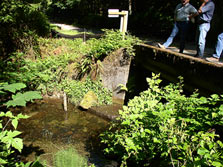










The Cedar River Watershed provides a major portion of the culinary water to Seattle, Washington, and several nearby cities. The watershed produces high-quality water that does not require a sand filter. To maintain that high quality, the city monitors and controls all uses within the watershed. The Bonneville Power Authority (BPA) needed to install a second major transmission line across the watershed (with all attendant soil disturbing activities associated with a job of this scope) and agreed to install an alarm system which would allow the city to turn off the water supply intakes in the event of a high turbidity condition in the river or in a selected tributary stream.
BPA contracted with Electronic Data Solutions to provide that alarm system. The system uses an FTS DTS-12 turbidity sensor, a Campbell Scientific, Inc., CR10X datalogger with a custom program written by Electronic Data Solutions, a low-band radio from Meteor Communications Corp. (MCC), and solar charged batteries for power.
A special challenge of this project was to get the alarm notification to Seattle Public Utility (SPU) rapidly so that action could be taken before the low quality water could reach the intakes. The area is mountainous and heavily timbered. Cellular coverage was spotty and deemed unreliable for this purpose. Standard satellite communication was judged too slow for this requirement and an on-site receiving station was too expensive for the project’s budget. Typical radio communication was hampered by terrain and the heavy timber.
The solution was found by using an existing low-band radio network already installed using repeaters on a series of high peaks throughout the area. The system was installed to track the locations of locomotives for the Burlington Northern Railroad. It has plenty of bandwidth for additional users and the low frequency has a large enough waveform to weave its way through the timber. The data is transmitted to a server in Kent, WA and the server automatically calls BPA and SPU when an alarm condition occurs.
Case Study Summary
Application
Monitoring the purity of Seattle's water supply during a construction projectLocation
Washington State, USAParticipating Organisations
Bonneville Power Authority, Seattle Public UtilityMeasured Parameters
TurbidityView the PDF